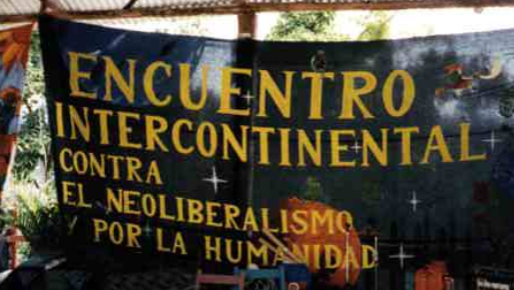By Raúl Zibechi
Photos by Andrew Flood of Ireland
In a way, on one hand there are the platforms, the social networks, and the huddled “masses” ; on the other the formation of collectives that embody the most diverse oppressions in the most distant geographies.
If there is something you cannot accuse zapatismo of, it is of not being coherent. For a long time now they have designed a politics of alliance amongst those from below, that they will now deploy during the tour that begins on European lands in June.
The Second Declaration of La Realidad for Humanity Against Neoliberalism, released in August of 1996, says it with clarity and transparency when it states: “We will make a collective network of all of our particular struggles and resistances. An intercontinental network of resistance against neoliberalism, an intercontinental web of resistance for humanity.”

Photo: Andrew Flood
The objective of this network is for the resistances of the world to find one another, to support one another mutually. And they clarify that the network is “not an organizational structure, it has no guiding or decision-making center, nor a central command nor hierarchies. The network is all of us who resist.
I believe that this declaration, that is now more than a quarter century old, illuminates what the Zapatistas want to do wherever they go. First they did it in Mexico, and went about weaving resistances of the indigenous peoples that gave life to the National Indigenous Congress (CNI), formed in 1996, and later to the Indigenous Governing Council (CIG), which was created in 2016.
The CNI adopted the 7 principles that the EZLN defined as the way to do politics; serve and not serve oneself; construct and not destroy, lead by obeying and not command, propose and not impose, convince and not conquer, to work from below, not seek to rise, and to represent and not replace.
The CIG is made up of 523 communities from 25 states of the country and 43 indigenous peoples. They affirm that “our struggle is not for power,” but to “strengthen ourselves in our resistances and rebellions, which is to say in the defense of every person, every family, collective, community or neighborhood.” (https://bit.ly/3rLJeWl).
The bearing of the EZLN, the CNI and the CIG is the construction of autonomies that collectively self-govern, based on another way of doing politics according to the above-mentioned principles.
It is important to point out that when they go on tour, as they always do, they are going to find the collectives that struggle, without importance to how many are involved, whether they appear in the mainstream media, or if they have more or less of an audience. It’s not about great acts with an illuminated platform for well-known people to go up and speak for the audience to listen, but rather to open spaces to talk amongst equals, to listen and learn, to say how each one is resisting, not to set a course for anyone.
Zapatismo embodies new forms of doing politics, below and to the left, ways that don’t have precedent in the anti-systemic movements of the 20th century. María de Jesus Patricio, Marichuy, spokeswoman for the CIG always says that, “when we are together, we are an assembly, and when we are apart, we are a web.”
In a gathering of women in February of 2018, Marichuy explained the campaign for the collection of signatures that they were conducting, as an excuse to dialogue with the people. “It was necessary to create a space, not so much an organization, so that there wasn’t someone leading and another obeying, but that we all felt we were part of this house.” The objective always consists of organizing from below, because in this way, “we can achieve the dismantling of power for those who hold power and money, those from the bad governments.” (https://bit.ly/3ulJk8R).
While traditional politics, as much on the right as on the left, directs itself to the great “masses” (a terrible word), to isolated individuals, the politics of the Zapatistas seeks to nest in organized collectives that resist the system.
While the dominant forms of doing politics, focused on elections, tend to dis-organize existing collectives, or at least weaken them, the EZLN, CNI and CIG seek the complete opposite: to motivate people to organize themselves, as a way of collectively confronting the evils of the system.
It is a politics that looks from below, not from above, but rather horizontally, below with below, among equals, to share, learn, and chart courses, respecting the ways and rhythms of each.
In traditional politics, big hierarchical organizations are created, in which a small group commands and the rest obey. Pyramids on whose pinnacles are generally installed men trained in academia who speak but don’t listen, who make decisions without consulting, who claim to speak in the name of people that they don’t even know.
In Zapatista politics, each collective speaks with its own voice, no one interprets nor represents it. The women and men who participate listen, ask, and try to learn.
In a way, on one hand there are the platforms, the social networks, and the huddled “masses”; on the other the formation of collectives that embody the most diverse oppressions in the most distant geographies. Media visibility, that does not move the system a single hair, as opposed to the patient and slow organization from below, that bets on containing the oppressions in order to dismantle them in an undetermined period, which in fact, has already begun.
In history, as capitalism permeated all of the pores of society, the political culture from below (which always existed, as the Commune of Paris demonstrates) was cornered, but it resurges with strength each time the people stand up.
I am speaking of the territorial assemblies of Chile; of the Ecuadorian indigenous and people’s parliament; of the Mapuche organizations and communities; of the Nasa and Misak councils in the south of Colombia; of the guards of self-defense that begin to populate our geographies in the Andes and the Amazon; of the hundreds of popular schools, of the community kitchens and health posts born during the pandemic.
These are the collectives that inspire us and from which we learn. The Zapatistas propose that we link up and listen to one another to face the system together.
This article was published in Naiz: on April 5th, 2021. https://www.naiz.eus/eu/iritzia/articulos/una-gira-por-abajo-y-por-la-izquierda This English interpretation has been re-published by Schools for Chiapas.
